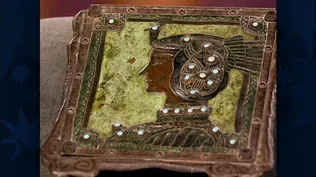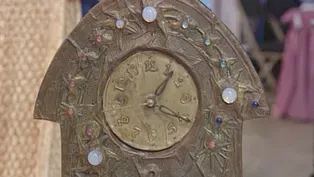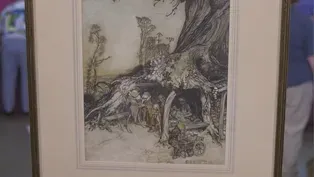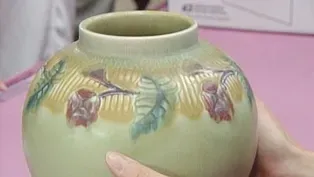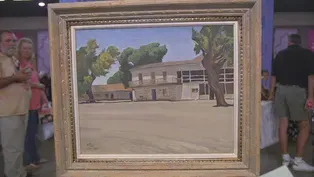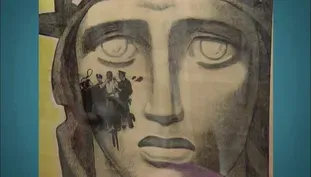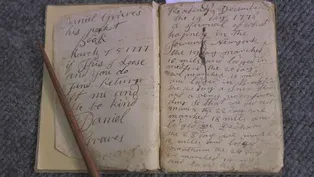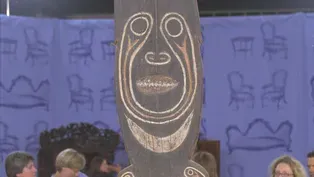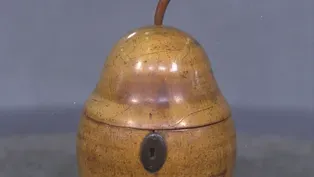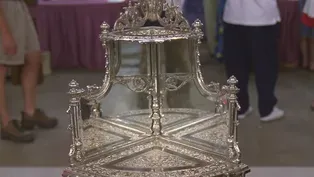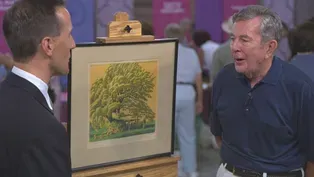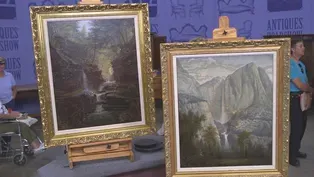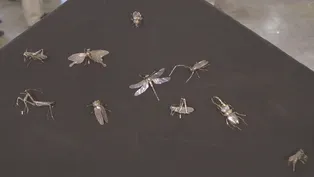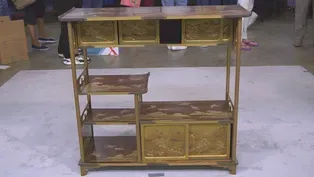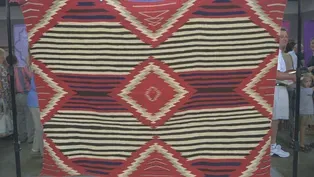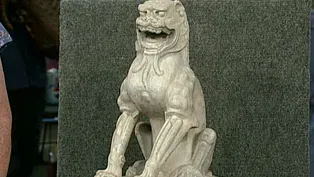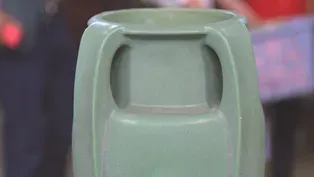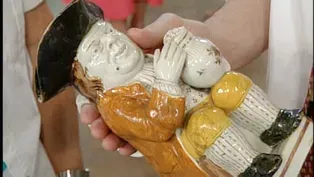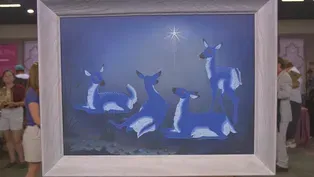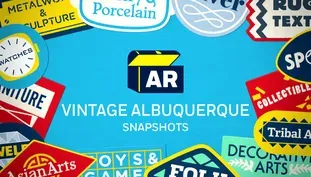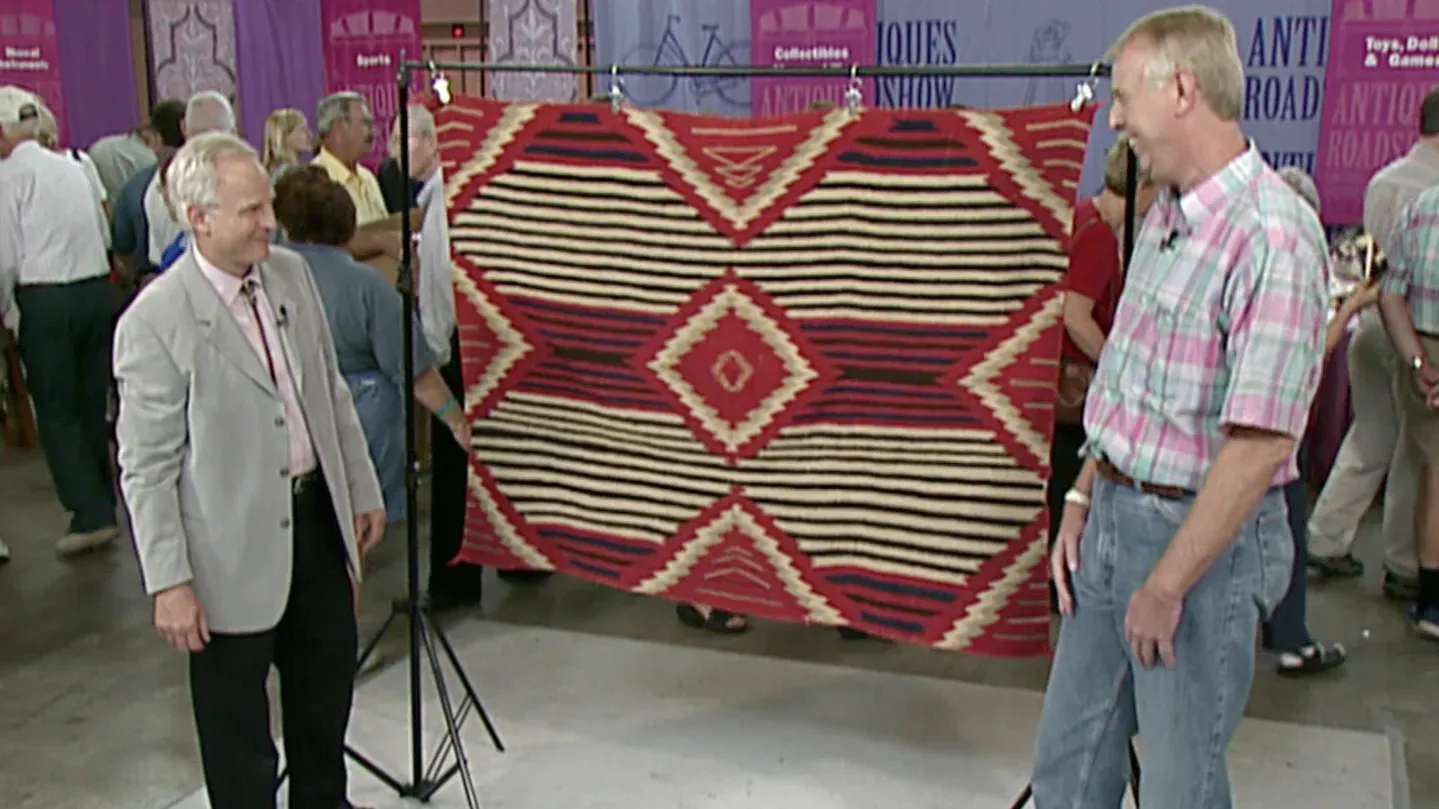

Vintage Albuquerque
Season 21 Episode 19 | 52m 23sVideo has Closed Captions
Revisit updated fan favorites from 2002, including a find that moves the expert to tears!
Revisit fan-favorite appraisals from 2002 that have been updated with today’s market value, including a magnificent Tang dynasty marble lion that moves the expert to tears. Has time impacted the value of this rare find?
Problems with Closed Captions? Closed Captioning Feedback
Problems with Closed Captions? Closed Captioning Feedback
Funding for ANTIQUES ROADSHOW is provided by Ancestry and American Cruise Lines. Additional funding is provided by public television viewers.

Vintage Albuquerque
Season 21 Episode 19 | 52m 23sVideo has Closed Captions
Revisit fan-favorite appraisals from 2002 that have been updated with today’s market value, including a magnificent Tang dynasty marble lion that moves the expert to tears. Has time impacted the value of this rare find?
Problems with Closed Captions? Closed Captioning Feedback
How to Watch Antiques Roadshow
Antiques Roadshow is available to stream on pbs.org and the free PBS App, available on iPhone, Apple TV, Android TV, Android smartphones, Amazon Fire TV, Amazon Fire Tablet, Roku, Samsung Smart TV, and Vizio.

ANTIQUES ROADSHOW 2025 Tour!
Enter now for a chance to win free tickets to ANTIQUES ROADSHOW's 2025 Tour! Plus, see which cities we're headed to!Providing Support for PBS.org
Learn Moreabout PBS online sponsorshipWhen your grandfather used it, it had probably come out of vogue as to what it really is.
Oh, really?
My mother paid $50 American, and a small portable washing machine.
A portable washing machine.
MARK WALBERG: Do you wonder why prices change when watching vintage Roadshows?
The answer is often simple.
As each new generation of collectors enters the market, they bring along their own tastes and preferences.
That changes demand, and the market follows.
Have people's tastes changed enough to affect the value of this English tea caddy?
Let's find out as we revisit Albuquerque.
WOMAN: This belonged to my grandfather, and I used to see it in the house that I stayed with them in Cambridge, Massachusetts.
He died before I was born, so I never even knew him.
You think it's a tobacco box?
Right.
I know that's what it was used for when my grandfather had it.
Very important distinction.
When your grandfather used it, it had probably come out of vogue as to what it really is.
Oh, really?
It is actually a tea caddy.
Oh, wow.
And this is, sort of instantly recognizable to people who collect English furniture and English decorations from the latter half of the 18th century.
And it's... literally it's a pear-shaped tea caddy.
Okay.
And made of pear wood.
Okay.
It's a really interesting form, because on the inside it was lined with foil to protect the tea.
Hmm, okay.
And we have a lock in the front here.
The reason that they locked up tea during this time period was tea was literally more expensive than gold.
Aha.
You didn't want the servants taking a couple of spoonfuls of tea out, so the lady of the house would have the key to open the tea caddy, and as is typical with tea caddies like this, you've got a little bit of damage here on the stem at the top, and around the back here where the hinge is.
But that's actually a really good sign of age, because they do make reproductions of these.
Ah.
And some original staining.
Some of this was a red stain that was around it, and the reason we can tell the old ones also is because it had a plug in the bottom.
Okay.
And with this old foil lining.
So, it dates from around 1790 or 1800.
So, it's a nice 200-year-old tea caddy.
What do you think it's worth?
I have no idea.
They're more common than you think.
Okay.
And when I get them I can get usually around $7,000 or $8,000 for them.
Oh, wow.
A very, very popular form.
MAN: My mother, when she was about 13, went with her family out to Colorado.
And I believe that's when they purchased it.
Uh-huh.
So, that's all I can tell you about it.
So, have you ever looked into what it is, or who made it, or...
I assume you know it's Navajo.
Well, I don't even know that.
You don't even know that?
Okay.
I just... that's the reason I'm here.
I don't know anything about it.
It's always been around, and I thought this would be a great time to find out what the deal is.
Okay.
Well, it's quite a nice Navajo weaving, from about the 1870s.
There are several things I like about it.
One is that it's a woman's wearing blanket.
Much more rare than a men's wearing blanket.
The way you can tell the women's blankets is the stripes, the smaller stripes cutting through the diamonds.
It's got beautiful indigo color in it.
It's got beautiful red bayeta.
And it's a great piece to hang up on the wall.
I understand there was some cleaning done at one time.
About seven years ago there was some smoke damage, and so it was cleaned.
Um, but that... you know, that's basically it.
Do you know how they cleaned it?
I have no idea.
The nap up here has a fuzzy quality.
There are actually... there are several places, but particularly up here.
Probably by cleaning, and I suspect they scrubbed it a little too hard.
And I don't know... from my knowledge I'm not sure if that can be restored or not.
It's still exceptional weaving, and it's a great classic, done in a Third Phase chief's pattern.
But whether or not that can be restored, I think remains to be seen.
Do you have any idea what it's worth?
I have absolutely no idea.
Now you've really perked my interest.
So, I don't know.
Well, I'm going to kind of go under the assumption that something can be done with that fuzziness.
But, even if it can't, I feel very strongly that, conservatively, it's a $15,000 to $20,000 weaving.
You're kidding me.
No, I'm not kidding.
(laughs) Holy mackerel.
$15,000 to $20,000?
$15,000 to $20,000.
(laughing) Thanks, Doug!
You're welcome.
What can I say?
My parents found this chair at a contemporary furniture store in Dallas, Texas, in 1950.
The reason that I really got excited about this chair is because of the original red color.
They came in red, or black, or natural wood finish.
And the red ones are very rare.
APPRAISER: I have an opinion.
I think that Tiffany actually took their cue from marketing that beautiful blue box that they use from this color, turquoise.
I don't know if that's true, but that's my opinion.
And I would say value-- $1,500 to $2,000.
WOMAN: Oh, great.
You were telling me that your mom and dad bought this guitar, what, back in the '60s?
'63, and it cost $174, plus tax.
They paid $15 a month.
This is a Martin D-18.
It was used when they bought it.
It was made in 1959.
The price range, with the original case and everything, we're probably looking at $2,000 or $3,000.
Priscilla, you have all sorts of information about this.
How long has it been in your family?
Well, at least 200 years that I can document, but my great-grandmother thinks it may have been longer.
Okay.
Well, when we see Toby jugs, which they still make in England and elsewhere, we like to know how old they are.
And I'll point out why we know this one is an old one, meaning it is about 200 years old.
Probably made about 1800.
First of all, I can feel it's very lightweight, and that's typical of the early ones.
Doesn't happen after the first period because it's made of something called pearl-glazed earthenware, which is very thinly potted.
And they stopped making that about 1820 or '30.
And the pearl-glazed earthenware is so called because it's off-white, and then it has a bluish tint in the glaze.
Wherever the glaze collects, which it's done around the eyes and in the furrows of the brow here and in the mouth, you can see in the thicker part of the glaze it's bluish.
And that's typical of pearl-glazed earthenware.
And you won't see that on reproductions or later ones made in the late 19th century or the 20th century.
So, those two features alone are enough to tell us it's an early one, first period.
It should really be insured probably for $1,600 or $1,800, which is the retail price for it if you like.
I brought in a canteen and a diary that belonged to my fourth great-grandfather.
It's come down through the family, some of the genealogy and other papers that we've saved over the years.
Who did the genealogical work?
I know a great-great-aunt had done some.
My father had done some.
I've done some.
You've done some, so it's a family contribution of putting this whole package together of your great-great-great- grandfather, Daniel Graves, from Reading, Massachusetts.
Yes.
This is a neat canteen that belonged to him when he was a lieutenant, and then a captain in the Massachusetts militia in 1794 and 1797.
It shows he was in the 2nd regiment, 1st brigade, 3rd division.
And then here's his name, D. Graves.
It's a wonderful post-Revolutionary War example of a good canteen.
But the highlight of all of this material, all of this documented material, is the journal that he kept.
And it starts out, "Diary of Daniel Graves.
"Found in an old book chest in a garret, by Mary Graves, before 1860."
And then in it is the whole history of his military experience from December of 1776 through March of 1777.
Starting out in Reading, Westchester County in New York, going into New Jersey.
Fighting Hessians.
Men freezing to death.
And what I'd really like to read is this-- you find this on powder horns.
Daniel Graves, his pocket book, March 5, 1777.
"If this I lose, and you you do find, "return it me and I'll be kind.
Daniel Graves."
I think that's wonderful.
But all through this are the story... the hardships that these men had to go through in the winter.
In one place water up to their hips marching to meet General Washington's army.
It's just a grand story.
Do you have any idea of the value?
No, I do not.
You don't?
I just know that it's something that we read and when the kids go through school and they start studying the Revolutionary War, we read it to them and it's something to expand their experience.
Well, I would say that this group, and the primary item is the diary, which is extremely rare, with the canteen, the diary, and all of your genealogical work, I would say it's a $35,000 to $45,000 package.
Well, thank you.
It's very interesting to hear about it.
As a family we look at it every ten years and go, "Oh, that's really neat," but it really belongs to America.
APPRAISER: I was very excited to see when you removed the bubble wrap today that you had an Arthur Rackham original.
I got it from the estate of James Langstroth.
He died in 1961.
He was my Boy Scout leader when I was in the Boy Scouts.
And we were very good friends all of our lives.
He was quite a collector of books, he was an outdoorsman and a true gentleman all the way.
Well, Arthur Rackham is probably the most celebrated children's book illustrator from England.
And he started out working in a fire insurance office while he took art classes, and from there he progressed to illustrating magazines before he went on to book illustration.
Some of his earliest book jobs were Grimm's Fairy Tales, and Peter Pan in Kensington Gardens.
And this really established him as a master of the art of illustration.
And you have some wonderful fairies here.
What did you say this is an illustration for?
This is an illustration from Midsummer Night's Dream.
It shows the making of the little elves' clothes.
And it's dated 1908 down here on the lower right.
There's a lot of detail.
They're sewing here in the background.
You must have an idea of what this is worth.
I wouldn't voice an opinion on it.
I didn't bring it up to sell it.
Well, I think at auction this would do very well.
I would say we might put something like $30,000 to $60,000 on it, but I would expect that it would sell towards the high end of that figure.
And for insurance purposes, you could even say as much as $75,000 or $80,000.
Thanks so much for bringing it in.
It's really a joy...
Thank you very much.
Always to see the work of Arthur Rackham.
Oh, yes.
I wish I had more of it.
MAN: Friend of mine that I lived with was a florist and he got it from a lady that he housesat for.
And we always had it in our house.
It always had fresh flowers in it.
It was always great for great big ginger, bird of paradise, big tropical plants that we have down in Florida is what we used it for.
But you know this is a piece of Teco pottery from the Chicago area.
The thing about this vase-- Teco made two different types of pottery.
They made a very organic ware, and they made a rather rectilinear or architectural ware.
And obviously we have a fairly architectural piece here.
You can see the strapped buttresses coming up and down the side of the piece.
That's what they were known for.
You have to bear in mind that Chicago at the time was in the process of being rebuilt after the great Chicago fire.
And so these new structures were going up and it influenced the decorative art that was featured inside of these buildings at the time.
So, Teco became very famous for many reasons, not the least of which is the quality of their commercial art ware.
This is a molded pot.
Teco was in business for a while, but this pot probably dates to about 1910.
Oh, by the way, here's the mark on the bottom of the piece.
It's die stamped into the pot.
Very typical for Teco.
But, you know, they produced the same mold for a period of time, so the pot could have been made 1906, 1916, somewhere around there.
Wow.
But, 1910 is a safe bet.
This is bigger than most Teco.
It's got the same glaze that most Teco comes with, this matte green.
Yeah.
I've always loved the color.
It's just great in the house and with house plants.
There is some damage, obviously.
There is four or five small nicks on the pot.
If you look inside the piece, you can see deposits from where it was used for plants and flowers over the years.
The deposits on the inside can be taken out with naval jelly.
Okay.
Okay?
I can do that.
The chips aren't really bad enough.
There's scallop shell edge chips that can be repaired.
Do you recommend that?
I would leave it alone, myself.
Okay.
And I would soak this-- because it's very dirty, I would soak this in something to leach the dirt out of the porous surface of the finish.
But, all things considered, the pot's in pretty good condition.
It really has very little damage.
So, if this pot were in mint condition it would be worth more, but still, in the condition it's in, it's a $15,000 piece of pottery.
Oh, my God!
In perfect condition this is about a $20,000 to $30,000 piece of Teco.
Oh, my gosh.
I had no idea.
None whatsoever.
It's a really good, strong, solid piece of Teco.
Had no idea of the worth.
APPRAISER: This little type of tiny tiles are called Italian micro-mosaic.
Okay.
And this was something made in Italy in the 19th century, and something that someone would have bought as a souvenir when they went to Italy or on their travels.
So this is a very early tourist souvenir.
It's a little ladle.
It is sterling silver.
A ladle like this is somewhere in the area of $30 to $35.
WOMAN: Okay.
WOMAN: This is just a picture of me when I was 12.
James Dean giving me an autograph.
And here's the autograph he gave you right here in this paperback copy of Giant.
This is absolute proof that James Dean signed, and not his secretary, and not the guy next door.
So you're sitting home watching the Roadshow?
Sitting home watching the Roadshow, and all of a sudden I see this box, I believe it was your Las Vegas episode.
Right.
And it was in a style... stylized with a woman on the front.
It was carved, and I heard the name "S.
Bing."
And I jumped up and I screamed, and I ran to the mantel, I pulled the clock off, and on the back of course is "S. Bing," who is basically the founder of the Art Nouveau movement as we know it.
Your clock actually is almost identical to this one.
It's almost identical, right.
And it's by Alfred-Louis Daguet, who made these metalwork boxes.
And it was retailed by Samuel Bing, as you said, and this is very nice too, because it actually says Daguet on the back here, and it's dated 1902.
It didn't have any movement when you bought it?
Right.
So you had this wonderful...
So I took it to a local antique clock dealer, and he said, "Well, there's really nothing we can do."
And so we put this piece in just to make it look like it's really working.
Which is okay, because then it makes it functional.
Most of these pieces are these small boxes, and don't have these kinds of jewels in it.
I would think this one in this condition is probably in the $3,000 to $5,000 range.
You're kidding me!
Right, right.
I thought, well, I spent $200 on it and I thought, well, you know, at least it's pretty.
I can look at it.
My wife and I were in Japan during the occupation.
Yes.
And she is a born shopper with exquisite taste.
And we were on the Ginza and she saw this piece and wanted it.
It was supposed to be an antique from a baron's estate.
And so we ended up acquiring it after a little bit of bargaining.
Did you live there for a while?
Yes, we did.
How long?
We lived there three years.
Mm-hmm.
And I did 30 years with the military, so this traveled with us all over the world, and most states.
What first attracted me when I saw it was first of all the quality of the lacquer work and the condition.
Oftentimes you can find pieces like this that have exquisite lacquer work, but are beat up through moving it around from place to place.
So, you've taken wonderful care of it.
I've always felt it was a museum piece.
Well, this is called a shodana, or a chigaidansu.
And it's meant to store tea ceremony implements in the home of a high-level official or a baron.
Okay?
This piece was executed in the Meiji period, between 1868 and 1911.
Probably in... near the Kyoto region, around 1890 or so.
This raised lacquer design is called takamakie, and it has a high gold content.
You can see many of these that are rendered that are a little weaker in the gold color.
This really shines brilliantly.
The quality of the workmanship of this piece is really remarkable, and plus, you add that to the symbolism, which is long life, and the landscapes are beautifully rendered.
What do you think it's worth?
Do you have any idea?
I have no idea.
I know it's too beautiful to damage, and I've taken very good care of it.
And the symbolism works, because I'm...
I'm going on 82, so...
Yes, it's probably stood you in good stead over the years.
This piece would bring probably between $10,000 to $15,000 at auction.
Is that all?
Is that all?
That's quite a bit.
If you kept it to insure it, you probably should insure it for about $25,000.
It's a wonderful, wonderful piece.
It's really exquisite workmanship.
Yes.
(laughs) Thank you very much for bringing it in today.
My pleasure.
MAN: Well, an elderly relative of ours retired from the east, and these I believe she gave to my mother, because they were kind of family oriented.
And so they've been in the bank vault for the last 50 years, I guess.
You mentioned that you know who the artist is who did the miniatures?
Yes.
A friend of my brother's went to the portrait gallery in Washington, and it was their belief that the picture, the two smaller ones were painted by somebody named Dunkerley.
That's correct.
What we have here are wedding gifts from Mr. Young and Mrs. Young to each other.
And they are done by the artist Joseph Dunkerley, who worked in Boston in the 18th century.
And, what's an interesting detail about these, if you look on the back of this miniature you see here, it says, "I.Y.
to S.R."
And then on the back of the lady's, it says, "S.R.
to I.Y."
So it's an interesting story about the husband and wife.
What I bet you didn't know is that Dunkerley was a tenant of Paul Revere in Boston.
I didn't know that.
The silversmith and patriot Paul Revere.
And, because of that, we can attribute the case and the engraving to Paul Revere.
Wow.
What also is another interesting element of this is the mourning picture, which sadly commemorates the death of their only daughter, Betsy, who passed away at the age of 12.
Have you ever had these appraised or have any idea of the value?
No.
Not at all.
If they were to come to auction today, I would estimate their value to be $15,000 to $20,000.
Wow.
(laughs) I'm sure my brother and sister will be happy to hear about that, I mean they're family things, though they wouldn't be sold, but it's nice to know the value of them.
WOMAN: Both of these pieces belonged to my great-grandmother.
And I have always loved them, and I'm kind of curious about what they might be worth.
And your grandmother lived in Albuquerque?
No, she lived in New York City.
She was born in New York City and lived there until she was 101.
This piece, this particular piece, what can you... what do you know about it?
That piece was made specifically for my great-grandmother.
And originally it had another row of those...
I think they're called cabochons?
Well, the piece was made by a company called Trabert, Hoeffer and Mauboussin.
They were actually bought by the French company Mauboussin.
This goes back to the '40s, and they designed a lot of jewelry actually for movie stars and quite famous people.
Oh, really?
This particular kind of jewelry made for customers was called reflections.
Okay.
The value of this necklace, because it's been repaired and sort of not in its original state is not going to be that high.
It's probably going to be about $1,000 to $1,500, which may be disappointing or not.
The piece that I do want to talk about is this beautiful ballerina.
And do you know anything about it?
Yes, my great-grandfather had it made for my great-grandmother.
Do you know who made it?
My mother thought it was Tiffany's, but I don't know.
No, it's not Tiffany.
It's actually Van Cleef and Arpels.
Made by them, New York City.
I just want to point out this head, the face of the woman is a rose-cut diamond.
It's one diamond that's used for the face.
And these are rubies and sapphires.
The skirt is all pierced lace, the signature is right here.
Okay.
Very, very collectible.
I'm going to give you a value on that piece, how's that?
Okay.
What do you think?
I don't have a clue, because I don't know-- the diamond head I don't even know.
How's $8,000 to $10,000?
Sounds pretty good!
Now are you going to wear it?
I actually wear this piece more because this...
I'm not even sure what you should wear it with.
Well, I think a dressy gown.
Yeah.
Thanks for coming to the Roadshow.
Thank you.
Well, this is done by Woody Crumbo, and Woody Crumbo did some work which he traded to Bill Ilfeld, who was a trader in northern New Mexico.
And Bill gave this to my dad as partial payment for some of the work my dad did.
Also because Bill's wife didn't like the painting.
I see.
So we got it.
Did your dad know Woody?
I don't know if he ever actually met Woody Crumbo.
He may have, but I'm not sure.
Well, back in the '70s, when I was a curator at an Indian museum in Oklahoma, Woody Crumbo was a close friend of my wife and mine, and spent many evenings out on his ranch out on the lake visiting with he and his wife and his son, Woody Max.
This painting was probably painted in the late 1950s.
That was the last that he did oil paintings on any scale.
The majority of Woody's oil paintings are in the Gilcrease Museum.
There are not very many in private hands.
The guy was a master painter.
He not only could paint Indian-style paintings which this one is, he also could paint portraits like any contemporary portrait painter.
He was just simply a master artist.
You said you had had it appraised.
What was the price?
Well, my parents sent off to Mr. Crumbo in the 1980s, and his daughter wrote back.
She said it was worth about $3,500 at that time.
We have the letter.
Well, Woody has since passed away, and things have changed.
I would say, conservatively, $20,000 to $25,000.
It could possibly bring 20% more than that without much trouble.
So... My dad will be very pleased.
Well, he should.
It's a masterwork by a master artist, who was also a wonderful gentleman and somebody I loved knowing in Oklahoma.
Great.
Thanks so much for bringing it in, Wendy.
Thank you.
It's really a great piece of art.
My dad will be just thrilled.
Well, I lived in Stockton, California, and I frequented a thrift store there and bought them in a thrift store.
It's interesting to see both the male and the female.
The pair of these together would easily make $1,600, maybe $2,000.
Oh, great, I'm thrilled.
A lot of people would confuse this piece thinking that it was English from the rainbow of colors.
You see that it has a blue, and then kind of a salmon and kind of a yellow with these beautiful oil spots.
However, the piece is Austrian or German.
So you think it could be Austrian?
This is Loetz.
It is Loetz.
It is Loetz.
I had a feeling.
It's very unusual to have an inscription.
This book was published when she was 90 years old, so you can see the shaky hand.
And so, uninscribed, it's a book that brings about $200 to $300, but inscribed, we think it's more like $2,000 to $3,000.
Oh, I see.
Okay, thanks!
What do you think this is?
Well, I think it's American art pottery and I thought it was Roseville.
I really don't know much about it at all.
It's interesting that you would think it is Roseville.
Because Roseville was in Zanesville, Ohio, and they did a lot of floral ware, a lot of matte glazes.
But they also... they worked... copying the works of the Rookwood pottery, which this is.
Oh.
So, this is the real thing.
Oh!
Right?
This is a very nice and quite rare piece of Rookwood pottery done in the Arts and Crafts style.
If you look underneath, you see from the Rookwood mark, which this is...
Okay.
The date, it's 1918.
That's quite early.
And this "C.S.T."
is the artist, Charles Todd, and he worked with them and he worked very much in this style, this is called an incised matte.
The colors are bright, the firing worked perfectly.
Very often they'll just drip, they'll drip so much that you have no idea what they were meant to be.
You know they were flowers but they'd become abstract.
And this, you see, on these flowers, the glaze has pretty much stayed where it was supposed to.
It's a nice contrast, with the red glaze and the light green body.
And green is a nice Arts and Crafts color.
So had this been what you thought was a piece of Roseville, would've been worth maybe a couple of hundred bucks.
Maybe three.
But this is a piece of Rookwood, and it's worth $1,000 to $1,500.
Really?
Yeah!
WOMAN: Well, I know that they are painted by James Hope, and they have been in my husband's family for years.
My husband's great-grandfather, I believe, bought these paintings from James Hope.
Okay.
James Hope, I was told, is from over in Europe.
I'm not sure, somewhere.
And he came over and apprenticed as a wheelwright and was injured.
And because he was injured he went into painting.
That's exactly true.
He was... Hope is an important American painter.
He was born in 1818, and came over when he was about 12 to Canada.
And then the story of injuring the ankle and painting.
He went on to painting portraits and then landscapes.
But he was born in Scotland, came here, and really established himself in New York as a portrait painter before he went into landscapes.
But these two paintings are different.
Do you know the subjects of these?
Well, this is Yosemite, Bridalveil Falls, and this is Watkins Glen, New York.
Okay.
This one, yes, it is Watkins Glen.
You see, it's signed "Hope" and dated 1872.
So this is almost his very first year in Watkins Glen.
He retired there and painted there.
This painting is a little different.
This is Yosemite.
Now, when you first brought this in, I had a hard time figuring out is this Bridalveil or is that Yellowstone Falls or is that Vernal Falls?
It has elements of all of them.
And somebody came by and said, "That looks like El Capitan."
Uh-huh.
There's a reason for that.
And the reason is he never went there.
And he only knew these from sketches Albert Bierstadt brought back.
So his paintings of Yosemite look very different from his paintings of Watkins Glen, because they were all done after copying sketches and photographs.
So, you'll see a very overall flatness to this.
Uh-huh.
His actual rock formations are not as exact either, so they're a little off.
So all this is very different when you start comparing that...
Right.
...with this here.
This is known as Rainbow Falls in Watkins Glen.
Here's the little rainbow, and he points that out.
Then you have all these atmospheric qualities here-- the light, the light coming through back here, all these beautiful observations that you would only have if you were there to see this, whh he didn't have in this thing, so it's a much more important painting because of that.
Have you had these appraised at all?
No, we haven't.
I was told that this was painted from a picture that he had that's in the family, somewhere.
So you never had them appraised or anything?
No, I sure haven't.
Well, the value on these have gone up a lot recently.
Years ago, they would only sell for $4,000 or $5,000.
They recently spiked.
A very large painting of this sold for a lot of money recently.
This one here, because it's not the observed reality, is probably worth about $10,000 to $15,000.
It's an important subject, but it's not the... his best work.
Right.
This is his best work.
Uh-huh.
One like this, probably be worth about $20,000 to $30,000.
Whoa!
That has always been my favorite, I love that one.
Yeah, it's a great painting.
Oh, it's just gorgeous.
As I said, the atmosphere of the light, all that, it's just so much more important than this one.
Oh, that's wonderful.
My dad was stationed in Japan in 1949.
My mother and I went in November of '49 and stayed through December of 1950, when the Korean War broke out.
And these came from a little village called Shibuya-Ku.
My mother paid 50 American dollars and a small portable washing machine.
A portable washing machine.
Yeah.
Well, kind of like the washing machine, all of these pieces have some considerable moving parts, as I think you've noticed.
They're all made of silver, and all finely articulated.
And beautiful examples of, like, each individual insect that's here.
You have the rhinoceros horn beetle, then you have a dragonfly, a cicada that you hear all over the plains in the summer.
A staghorn beetle.
Then you have this insect, that I'm not certain what type it is, but the thing that's amazing about it is the articulation that you're seeing on it.
Every single thing on this moves.
The wings move, the legs move.
And they'll come back as well.
Yeah, they're magnificently done.
These are from the Meiji period.
Ah, they are Meiji.
I thought they were Edo.
Yeah, no, they're Meiji.
Made between like 1868 and 1911.
And what happened was, in about 1873, there was an edict forbidding the wearing of swords.
So all the armorers that used to make sword armor started manufacturing pieces like this to sell to the tourist trade.
And they were making them out of very, very expensive and exotic materials, like the silver that these are made of.
They're just very, very finely crafted, great workmanship and basically this workmanship pretty much died after the First World War.
You know, all of a sudden, they weren't making them quite as detailed.
Like, you have this one here, the wasp that's down in the bottom, and it's amazing.
The thing is so articulated that you can even see the stinger come out on it.
It's incredible.
You know, just a wonderful piece of workmanship.
You know, then they have to have a counterpin in there to make sure it doesn't stick at all.
They're incredible.
And she paid $50 for them and a washing machine?
50 American dollars.
Do you have any idea what they're worth now?
No, I don't.
I'm hoping they're worth a lot.
Well, they are.
They're... individually, they're worth between $3,000 to $5,000 apiece.
Holy cats!
So you're talking like $30,000 to $50,000 here on the table.
Oh, my goodness.
And I know that because recently I had a sale where I had an articulated dragon.
It was much larger, but still more common than these are.
That sold for $11,000.
Whew!
So, these are just incredible examples.
(laughs) That is outstanding.
WOMAN: These were given to me by a friend and my friend's grandmother sent these binoculars to the United States government, just at the start of the First World War when they asked for binoculars, telescopes, whatever would "be the eyes of the Navy" during that war.
And they sent her documentation with a check for $1 as a rental fee.
And if they were able to return it at the end of the war, then the rental fee became a purchase fee, or rather vice versa.
And this letter here actually mentions the enclosed check payable to your order.
Correct.
You're right, there was this program called "Eyes for the Navy."
It wasn't at the beginning of the war, it was actually shortly after the U.S. entered the war, but it wasn't until 1918.
And a lot of citizens responded.
Your friend's grandmother here has noted that she loaned her binoculars to the Navy.
And they actually got used.
They were sent to France.
We have the tag that got attached to them.
She got a thank you note from the Assistant Secretary of the Navy.
No big deal except that the Assistant Secretary of the Navy at that time was Franklin Roosevelt.
Yes.
He did climb the political ladder before he became president.
Most remarkable of all, though, is that at the end of the war, what happened to the binoculars?
They sent them back to her, which is amazing.
So, at one time, at least, the government was efficient.
Very.
We've seen letters like this with some frequency.
Obviously, a lot of patriotic citizens responded to this call and did send eyeglasses, spectacles, binoculars, spyglasses.
And over the last ten or 15 years, I looked in the auction records, and about a dozen of these had been sold, none for more than $500.
Oh, okay.
But what I think is interesting is the evidence that the binoculars were used by the Navy during the war, and the binoculars themselves.
I think that enhances the value significantly.
I'd say it brings it up to something in the range of $2,000 to $3,000.
Oh, excellent.
Because it's so unusual, a lot of people would keep the letter because it had Roosevelt's signature, but most people wouldn't keep the envelopes, the other documents, the tag, and probably not many of them could have gotten the binoculars back.
(laughs) So, I enjoyed seeing it.
I didn't realize before there was this dollar fee, so not only do the people who come to the Roadshow learn things, the appraisers do, also.
So, I appreciate it.
Great.
Thank you!
You're very welcome.
The binoculars, as binoculars, are probably worth less than $100.
This is a corner stand that I inherited from my grandparents.
They got married in 19... 1895, and it was in their home, in their dining room, and that's all I know about it.
My hunch is that it's made in England, if for no other reason it has these lion mask decorations on each of the shelves, which are... is a pure English motif.
Corner stands are unusual.
They are also known as whatnot stands.
Very rare item.
Silver furniture, in my 40 years in the business, I've never seen any.
So, it's exceedingly rare.
It's silver plate, but it's still silver.
Of course, it has this beautiful beveled glass, which enhances the value of it.
Do you have any idea what it might be worth?
None whatsoever.
Well, I discussed it with some of my colleagues and in a well-advertised auction, a silver stand like this would sell somewhere in the range of $5,000 to $7,000.
Oh, my goodness.
Thank you very much for bringing it to the Roadshow.
Thank you for having me.
MAN: This is a photograph of Lewis Douglass and his discharge papers from the 54th Massachusetts Regiment.
Lewis Douglass was my... the brother of my great-grandmother, who was Frederick Douglass' first child.
APPRAISER: I would guess, oh, I don't know, $3,000 to $4,000 for the photograph and the discharge paper, simply because of who it was.
My father actually got them when he was 11 in Southern California.
He ended up paying $5 for the whole box.
Excellent.
He probably bought $6,000 to $8,000 worth of baskets way back when for $5.
About 25 years ago, a friend of mine that owned rental properties called me and said that it had been abandoned in a closet, and he thought it was ugly, but he said, "Steve, I think it's ugly right up your alley.
Would you like to have it?"
And you said yes.
I said absolutely, it was one of the most gorgeous lamps I had ever seen.
MAN: Well, it was given to me by my aunt, who was in Russia in the early '60s, I want to say '64, '65.
She picked it up and brought it back to the States probably in the late '60s when they were transferred back.
The number one question that I am always asked about posters, any poster-- a French poster, a German poster, an American poster-- is how many were printed?
And we never actually know.
We can surmise a few thousand.
We can figure if a few thousand were printed, not all survived.
But the Russians always printed on their posters the number of posters that were printed in the run.
Oh.
So if we look down on the bottom here, it's really small, this is one of 30,000 posters.
Okay.
Now, I say it's a good thing because we know how many were printed.
It's a bad thing because 30,000 is a lot.
And in the market of supply and demand, the more of something there is, the smaller the value is going to be.
Okay.
All right, so that's the good and the bad.
Now, the image itself is so strong.
I mean the face of American democracy, that's sarcastic.
You have the Statue of Liberty here with a 5:00 shadow.
You have policemen beating up an African-American man.
The Statue of Liberty is looking very sad and forlorn at this miscarriage of justice.
I mean, it's a tremendous message.
You know, back in 1962, this was the year after the Berlin Wall went up, we weren't very friendly with the Russians.
I mean, it's a real window...
Very tense time.
That's right, it's a real window into that time.
Now, value-wise, the value is not that high.
The value would be between $300 and $400.
Okay.
WOMAN: Well, I got it through my husband's family.
He got it from his aunt, and I was very interested to learn it was originally Dutch because the family was originally Dutch, so that made it extra special.
I'll tell you a little bit about it, Jane.
You mentioned Italian... you thought possibly when you came in.
Yes.
Because of the Latin text below.
It's a book done by a well-known Flemish artist named Johannes Stradanus.
He's an interesting character.
His Dutch name was Van der Straet.
So, your instinct was right, the Latin name and the Latin below, would make you think of Italy.
He was born in Bruges.
He moved down to Italy in the 1550s, he was born in 1523, and he worked with the famous art historian Vasari.
And he worked on some very large and important commissions of tapestries.
And the tapestries he designed were often filled with hunting scenes, fishing scenes, fowl scenes, and this is what you have here.
And he became very well known for that.
He studied with some very important Italian mannerists.
He did some work for Cosimo de Medici's palaces.
So, he spent most of his working career in Italy.
So you were not far off.
And you mentioned earlier that the landscapes didn't look very Dutch to you.
And for people who have been in Holland would know, that it does not look like a Dutch landscape at all.
No, no.
But, in fact, it is very Italianate in style.
The book is very rare.
His artwork is very rare.
There's 104 of these wonderful engravings, fine quality.
It's the first edition, which was published in Antwerp in 1578.
And these don't come up every day.
Let me tell you, Jane, this book, were it to come up at auction, we would safely put an estimate of $20,000 to $30,000 on it.
You're kidding.
I hear them say "You're kidding" all the time on the program.
We're not kidding.
You're kidding!
We don't kid you.
This is really... That's amazing.
...an unbelievably rare book.
You've got a real treasure on your hands.
And thank you for bringing it in, we appreciate it.
Thank you so much.
Thank you.
Well, this painting was given to my grandparents because Maynard was my grandfather's first cousin.
So there's a very personal attachment to it.
And Maynard died before I was around, but.. What is the scene?
Well, it's called The Old Stage Station and I really don't know very much about it.
I'm thinking it was probably in Arizona, but I don't know.
Well, Maynard Dixon had a really interesting career.
He was born in 1875 in California, and in the beginning of his career, up until the '20s, was a fairly commercial artist.
And then, after his marriage, actually, to Dorothea Lange, he decided to really break out.
And that's in the '20s when he did the fabulous Western scenes with the Navajo and the Hopi Indians and the great, great expanses of the West.
They write about Maynard Dixon as really understanding the space and the loneliness of the West, and in this later piece, I think we can see that, too.
Maynard Dixon's great period right now is those great Native American scenes of the '20s, from 1920 to 1929.
One recently sold for over $1 million.
They're estimated often between $300,000 and $600,000.
Tremendously valuable paintings.
As a later example of his work, I'd estimate the painting at between $30,000 and $50,000.
Well, thank you very much.
Thanks for coming.
WOMAN: My grandparents picked it up.
They traveled a lot in China.
And when were they in China?
Probably the early part of the century.
Okay, and where have you had this since then?
My mother's had it in her house.
Okay.
And then I inherited it and brought it west.
Some years ago, she knew someone who knew about Chinese art and he looked at it and he said it was from the Ming Dynasty, he thought.
And priceless.
And that's all I know.
Okay.
Well, I'll start out by saying when this came up, I could barely... (laughs nervously) I could tell.
(voice breaking): It's fantastic.
This is truly...
Sorry, I'm a little worked up.
This is among the finest examples of Chinese art that we have seen on the Roadshow.
The carving is beautiful.
The workmanship is stunning.
The carver who did this was truly a master.
You can see the muscles rippling under the surface.
It's the finest quality marble you can get.
It's truly magnificent.
And as you look at this, any way you look at it, it's fantastic, it's breathtaking.
I see little tiny versions of these that come in for sale, but never does one see one like this.
Wow.
Now, one of the things he was wrong about is it's not Ming Dynasty.
Huh.
This dates from the golden period of Chinese art, which is called the Tang Dynasty between the sixth century and the ninth century.
Wow.
Your grandparents bought something when they were on their trip that you can't get now.
You can see examples like this in museums.
Occasionally they come up at auction.
It's wonderful.
Time to pass it on.
Now one of the ways that I can tell you that it's what it's supposed to be, not only just from the artistic aspects of it, because that tells us clearly that this was done by a master work as a master carver, but when you look at it underneath, you can see that there's every indication of great age from the chisel work that has taken place to the sort of sandy surface, which is fantastic, that gives you the kind of patina that you want to see.
It's something that's been handled, and it's been around for a while, it's a great thing.
The artist didn't sign it.
No, these were never signed.
I would feel pretty confident that one could get between $120,000 and $180,000.
Wow.
For it.
Not that I'd sell it.
It's a fantastic, fantastic thing.
Now, the value I gave you is an auction estimate value.
An insurance figure on this would be somewhere between $150,000 and $250,000.
Probably toward the high end, I would say around $250,000.
Wow.
For insurance purposes.
I'm just really pleased.
So it was worth lugging it in here.
Yeah, it's wonderful.
It's a Gustave Baumann print.
It's titled Winter Corral.
We bought it in Santa Fe in June of 1970 and I still have the original bill of sale, which was $95.
Do you know anything about the artist?
No, my wife was familiar with him.
That's the reason we bought it, at her insistence.
And she heard that he was a fairly good woodblock artist, and so she said buy it, and we did.
Well, he was born in Germany and his family moved to Chicago in the early 1900s.
And as the story goes, as a teenager, he was in a bar, in Chicago, and met a friend there.
And he was talking to this fellow and he said, "I just got back from New Mexico and you really should go there, it's a wonderful place."
So, two years later, in 1918, Baumann ends up in Santa Fe.
And he becomes one of the central figures in the Santa Fe artist colony.
His prints are just beautifully colorful.
It's what his work is known for.
He lived until 1971 in Santa Fe, and created hundreds of color woodcuts.
Now, you said you've had it for about 30 years.
Yes.
Did you ever have it evaluated in that time?
No.
No, we did not.
And you bought it at a gallery in Santa Fe, right?
Yes.
In three easy payments-- $35, $30, and $30 on monthly payment.
Well, I should tell you, the color woodcut market right now for color woodcuts made in the first half of the 20th century is incredibly strong.
And Baumann, being such a well-known artist, his prices are phenomenally strong right now.
So, the value of this piece has increased quite dramatically.
Would you hazard a guess as to what this is worth today?
No, no, I'm not good at guessing.
If my wife were here she might, but not me.
Well, first of all, it's in beautiful condition.
You've kept this very well.
Color woodcuts have a tendency to fade if they're exposed to light over time.
And this obviously hasn't.
The colors are still as bright as they should be.
Doesn't look to me like there are any condition flaws.
At auction today, conservatively, I would expect this to sell for around $10,000.
So, you've done quite well with it over 30 years.
Thank heaven to have a smart wife.
And it's wonderful to have something always of local interest on the show.
Oh, for heaven's sake.
Well, thank you very much.
Thank you for bringing it.
Thank you, Todd, thank you.
You're welcome.
WALBERG: I'm Mark Walberg, thanks for watching.
See you next time on Antiques Roadshow.
Appraisal: 1578 Johannes Stradanus Book of Prints
Video has Closed Captions
Clip: S21 Ep19 | 2m 22s | Appraisal: 1578 Johannes Stradanus Book of Prints, in Vintage Albuquerque. (2m 22s)
Appraisal: 1902 Alfred-Louis Daguet Clock
Video has Closed Captions
Clip: S21 Ep19 | 1m 16s | Appraisal: 1902 Alfred-Louis Daguet Clock, in Vintage Albuquerque. (1m 16s)
Appraisal: 1908 Arthur Rackham Illustration
Video has Closed Captions
Clip: S21 Ep19 | 2m 2s | Appraisal: 1908 Arthur Rackham Illustration, in Vintage Albuquerque. (2m 2s)
Appraisal: 1918 Rookwood Pottery Vase
Video has Closed Captions
Clip: S21 Ep19 | 1m 41s | Appraisal: 1918 Rookwood Pottery Vase, in Vintage Albuquerque. (1m 41s)
Appraisal: 1935 Maynard Dixon Oil Painting
Video has Closed Captions
Clip: S21 Ep19 | 1m 41s | Appraisal: 1935 Maynard Dixon Oil Painting, in Vintage Albuquerque. (1m 41s)
Appraisal: 1963 Russian Propaganda Poster
Video has Closed Captions
Clip: S21 Ep19 | 1m 41s | Appraisal: 1963 Russian Propaganda Poster, in Vintage Albuquerque. (1m 41s)
Appraisal: Ballerina Brooch & Monogram Necklace
Video has Closed Captions
Clip: S21 Ep19 | 2m 24s | Appraisal: Ballerina Brooch & Monogram Necklace, in Vintage Albuquerque. (2m 24s)
Appraisal: Canteen & Revolutionary War Diary
Video has Closed Captions
Clip: S21 Ep19 | 3m 1s | Appraisal: Canteen & Revolutionary War Diary, in Vintage Albuquerque. (3m 1s)
Appraisal: Decorative Papuan Protective Figure
Video has Closed Captions
Clip: S21 Ep19 | 33s | Appraisal: Decorative Papuan Protective Figure, in Vintage Albuquerque. (33s)
Appraisal: English Pearwood Tea Caddy, ca. 1795
Video has Closed Captions
Clip: S21 Ep19 | 2m 10s | Appraisal: English Pearwood Tea Caddy, ca. 1795, in Vintage Albuquerque. (2m 10s)
Appraisal: English Silverplate Corner Stand, ca. 1880
Video has Closed Captions
Clip: S21 Ep19 | 1m 32s | Appraisal: English Silverplate Corner Stand, ca. 1880, in Vintage Albuquerque. (1m 32s)
Appraisal: Gustave Baumann Woodcut, ca. 1940
Video has Closed Captions
Clip: S21 Ep19 | 2m 51s | Appraisal: Gustave Baumann Woodcut, ca. 1940, in Vintage Albuquerque. (2m 51s)
Appraisal: James Hope Paintings, ca. 1875
Video has Closed Captions
Clip: S21 Ep19 | 3m 15s | Appraisal: James Hope Paintings, ca. 1875, in Vintage Albuquerque. (3m 15s)
Appraisal: Meiji Period Silver Insects
Video has Closed Captions
Clip: S21 Ep19 | 3m 2s | Appraisal: Meiji Period Silver Insects, in Vintage Albuquerque. (3m 2s)
Appraisal: Meiji Shodana, ca. 1890
Video has Closed Captions
Clip: S21 Ep19 | 2m 42s | Appraisal: Meiji Shodana, ca. 1890, in Vintage Albuquerque. (2m 42s)
Appraisal: Navajo Woman's Wearing Blanket, ca. 1875
Video has Closed Captions
Clip: S21 Ep19 | 2m 24s | Appraisal: Navajo Woman's Wearing Blanket, ca. 1875, in Vintage Albuquerque. (2m 24s)
Appraisal: New England Tall Case Clock, ca. 1820
Video has Closed Captions
Clip: S21 Ep19 | 1m 3s | Appraisal: New England Tall Case Clock, ca. 1820, in Vintage Albuquerque. (1m 3s)
Appraisal: Tang Dynasty Marble Lion
Video has Closed Captions
Clip: S21 Ep19 | 3m 13s | Appraisal: Tang Dynasty Marble Lion, from Vintage Albuquerque. (3m 13s)
Appraisal: Teco Vase, ca. 1910
Video has Closed Captions
Clip: S21 Ep19 | 2m 34s | Appraisal: Teco Vase, ca. 1910, in Vintage Albuquerque. (2m 34s)
Video has Closed Captions
Clip: S21 Ep19 | 1m 26s | Appraisal: Toby Jug, ca. 1800, in Vintage Albuquerque. (1m 26s)
Appraisal: Woody Crumbo Oil Painting, ca. 1955
Video has Closed Captions
Clip: S21 Ep19 | 2m 17s | Appraisal: Woody Crumbo Oil Painting, ca. 1955, in Vintage Albuquerque. (2m 17s)
Providing Support for PBS.org
Learn Moreabout PBS online sponsorshipSupport for PBS provided by:
Funding for ANTIQUES ROADSHOW is provided by Ancestry and American Cruise Lines. Additional funding is provided by public television viewers.


